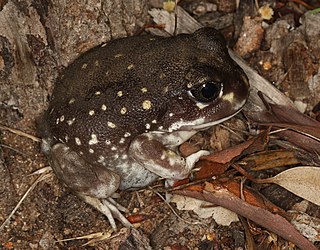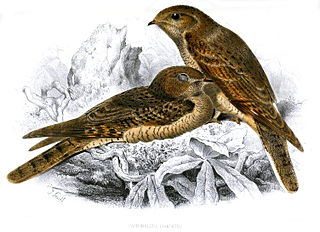
The giant burrowing frog or eastern owl frog is a large frog species that occurs in coastal south-east New South Wales and Victoria in Australia. It is also known as the owl frog, southern owl frog, spotted owl frog, burrowing owl frog.

The oak titmouse is a passerine bird in the tit family Paridae. The American Ornithologists' Union split the plain titmouse into the oak titmouse and the juniper titmouse in 1996, due to distinct differences in song, preferred habitat, and genetic makeup.

Heleioporus is a genus of frogs native to Australia. Of the six species in this genus, five live in south-west Western Australia, while the other one species only occurs in south-eastern Australia. All members of this genus are medium to large sized burrowing frogs with rounded heads, short bodies, bulging eyes, short limbs and the hands are free from webbing. The toes are relatively short with only a trace of fleshy webbing. A characteristic of this genus is the black nuptial spines that male frogs have on their first and occasionally second and third fingers. The pupil restrict to form a vertical slit and the tympanum is usually distinct. All the species in this genus call from burrows where the eggs are later deposited in a foam mass. Embryos develop in this mass until hatching. Hatching occurs after the burrows are flooded with water, and may be delayed until this happens. The calls of these species are similar although differ in frequency, length, note and repetition rate.

Limnodynastidae, commonly known as the Australian ground frogs, is a family of frogs found in Australia and New Guinea.

The Italian agile frog, also known as Lataste's frog, is a species of frog in the family Ranidae. The species is native to southern Europe.

The Sudell's frog, painted burrowing frog, trilling frog or desert trilling frog is a species of burrowing frog common to a large part of southeastern Australia. It is found on and west of the Great Dividing Range of New South Wales to western Victoria and southern Queensland as well as far eastern South Australia.
Hyperolius inornatus is a species of frog in the family Hyperoliidae. It is endemic to Democratic Republic of the Congo. Its natural habitats are rivers, swamps, freshwater marshes, and intermittent freshwater marshes.
Pleurodema bibroni is a species of frog in the family Leptodactylidae. Its common name is four-eyed frog, although this name can also refer to the genus Pleurodema in general. The common name refers to two inguinal poison glands that resemble eyes. When threatened, the frog lowers its head and raises its rear. When the frog adopts this posture the poison glands are also raised toward the predator. The predator may also confuse the frog's raised posterior for the head of a larger animal.

The western spotted frog is a species of frog in the family Limnodynastidae. It is endemic to Western Australia. Its natural habitats are temperate forests, temperate shrubland, intermittent rivers, freshwater marshes, rocky areas, granite outcrops, arable land, pastureland, open excavations, and canals and ditches. It is threatened by habitat loss and salinity.
The hooting frog is a species of frog in the family Limnodynastidae. It is endemic to Australia. Its natural habitats are temperate forests and intermittent rivers.
The sand frog is a species of frog in the family Myobatrachidae. It is endemic to southern Western Australia. Its natural habitats are temperate forests, temperate shrubland, Mediterranean-type shrubby vegetation, shrub-dominated wetlands, swamps, intermittent freshwater lakes, and intermittent freshwater marshes.

The plain nightjar is a species of nightjar in the family Caprimulgidae. It breeds in the southern Sahel, Southern Sudan, the Horn of Africa and the southwestern Arabian Peninsula. It migrates to lower latitudes - including central Congo and northern Tanzania. A rather plain looking nightjar with grey-brown, brown, and rufous morphs. Males have white spots on primaries, large white corners to tail, and no white on the throat Females have buffy-brown wing spots, and no white on the tail.

The rufous-fronted thornbird is a species of bird in the family Furnariidae.

The Timor friarbird or plain friarbird,, is a species of bird in the family Meliphagidae. It is found on Timor island. Its natural habitat is subtropical or tropical dry forests.

The stripe-breasted rhabdornis, also known as the stripe-breasted creeper or plain-headed creeper, is a species of bird currently placed in the starling family, Sturnidae. It is endemic to the southern and central Philippines. The Visayan rhabdornis is now usually considered a distinct species, where previously it was considered a subspecies. The grand rhabdornis of Luzon Island is sometimes regarded as a subspecies, but usually now considered a distinct species as well.

The inornate squirrel is a species of rodent in the family Sciuridae. It is found in China, Laos, and Vietnam.
H. inornatus may refer to:

The Arnhem leaf-nosed bat is a species of bat in the family Hipposideridae. It lives in the sandstone areas of Kakadu National Park.

The plain thornbird is a species of bird in the ovenbird family Furnariidae.












